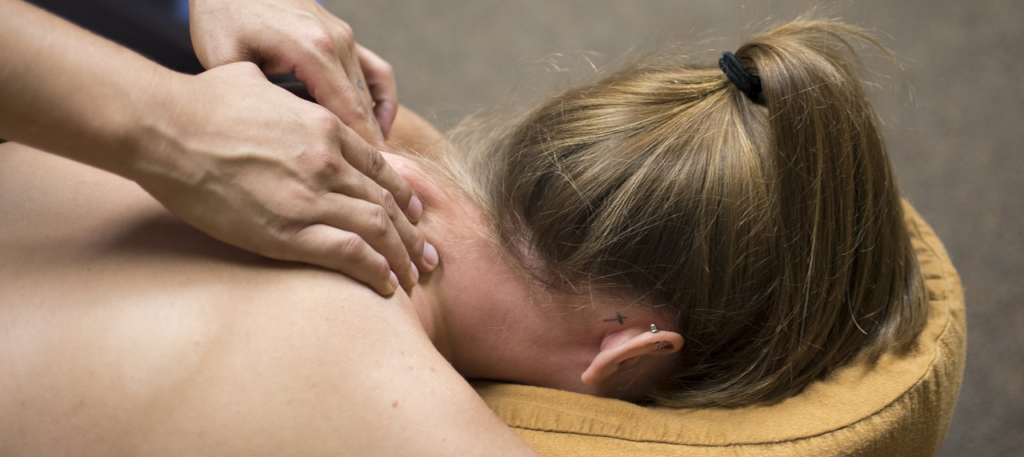Lewis, Cynan et al.: Strain-Counterstrain therapy combined with exercise is not more effective than exercise alone on pain and disability in people with acute low back pain

Datenerfassung
Das primäre Ergebnis wurde mit einem modifizierten Oswestry-low-back-pain disability-Fragebogen nach zwei Wochen, sechs Wochen und 28 Wochen erfasst. Die sekundären Messungen betrafen den „SF-36, visual analogue scale pain ratings, and a 7-point global rating of change”.1Ebd., S. 92.
Ergebnisse
Am Ende des zweiwöchigen „Interventionszeitraums“ zeigten sich zwischen den beiden Gruppen keine signifikanten Änderungen im mofizierten Oswestry-Disability-Index, auch nicht in einer der zusätzlichen Messungen oder in Hinblick auf die Verwendung von Schmerzmitteln.
Der einzige signifikante Unterschied zwischen Versuchs- und Kontrollgruppe fand sich unmittelbar nach den Behandlungen. Die Versuchsgruppe zeigte dabei einen mittleren Wert von 2,9, die Kontrollgruppe von 3,5 – ein Unterschied von 0,6 Punkten.
Diese Unterschiede fanden sich allerdings nicht mehr in den Untersuchungen nach 6 und 28 Wochen. Auch hinsichtlich der erforderlichen weiteren Behandlungen oder der Medikamentengebrauch zeigten sich keine Unterschiede, und in keiner der beiden beobachteten Gruppen ergaben sich negative Auswirkungen.
Schlussfolgerungen
Die Autor*innen sehen auf Basis ihrer Ergebnisse keine Notwendigkeit, Strain-Counterstrain-Behandlungen bei akuten Schmerzen im unteren Rücken zu empfehlen, schränken ihre Aussage aber unter anderem dahingehend ein dass es eine Patient*innengruppe geben könnte, die von dieser Behandlung profitiert.2„Our findings should be considered within the context of the limitations of the study design. Since this trial was conducted in a clinical setting with the majority of participants referred by medical practitioners for physiotherapy treatment, it was not possible to incorporate a control group that did not receive physiotherapy intervention. Consequently, we were unable additional treatments such as Strain-Counterstrain and other to determine the degree to which significant improvements in outcome measures for both experimental and control groups were due to the natural history of acute low back pain. Due to the type of intervention, it was not to blind the physiotherapist who provided interventions. Because no sham-experimental intervention was included in the study design, it was not possible to determine the degree to which the manual contact in the experimental group influenced outcome measures. No attempt was made to control for medications taken by participants, which included opioid and non-opioid analgesics and non-steroidal anti-inflammatory drugs” (http://www.journalofphysiotherapy.com/article/S1836-9553(11)70019-4/pdf, S.96). Das allerdings allerdings könnte erst aus nachfolgenden Studien abgeleitet werden.
Anmerkungen/Fußnoten
- 1Ebd., S. 92.
- 2„Our findings should be considered within the context of the limitations of the study design. Since this trial was conducted in a clinical setting with the majority of participants referred by medical practitioners for physiotherapy treatment, it was not possible to incorporate a control group that did not receive physiotherapy intervention. Consequently, we were unable additional treatments such as Strain-Counterstrain and other to determine the degree to which significant improvements in outcome measures for both experimental and control groups were due to the natural history of acute low back pain. Due to the type of intervention, it was not to blind the physiotherapist who provided interventions. Because no sham-experimental intervention was included in the study design, it was not possible to determine the degree to which the manual contact in the experimental group influenced outcome measures. No attempt was made to control for medications taken by participants, which included opioid and non-opioid analgesics and non-steroidal anti-inflammatory drugs” (http://www.journalofphysiotherapy.com/article/S1836-9553(11)70019-4/pdf, S.96).
Pages: 1 2